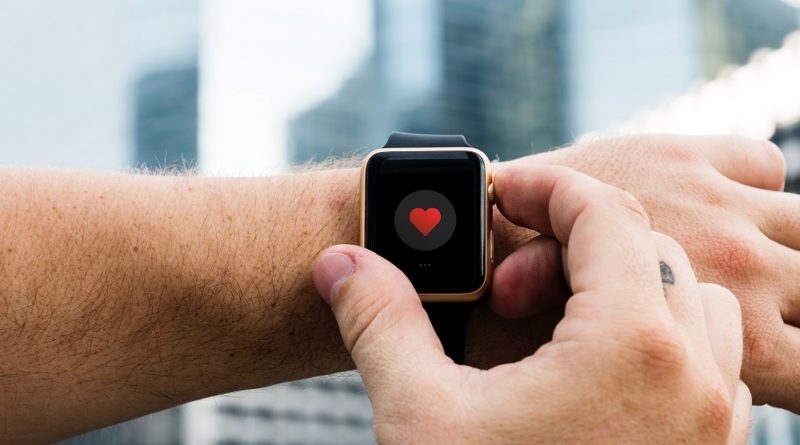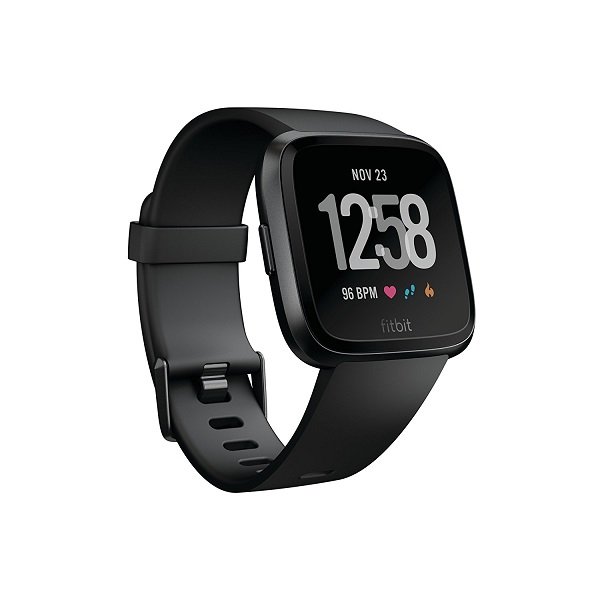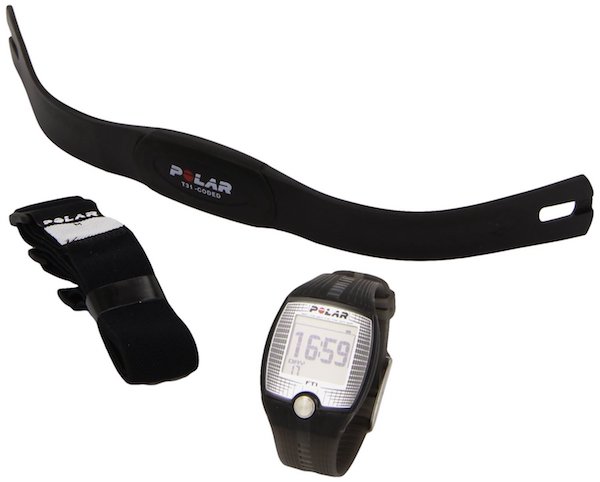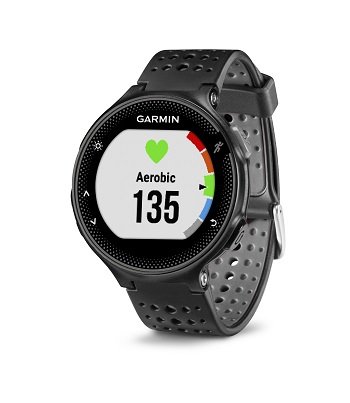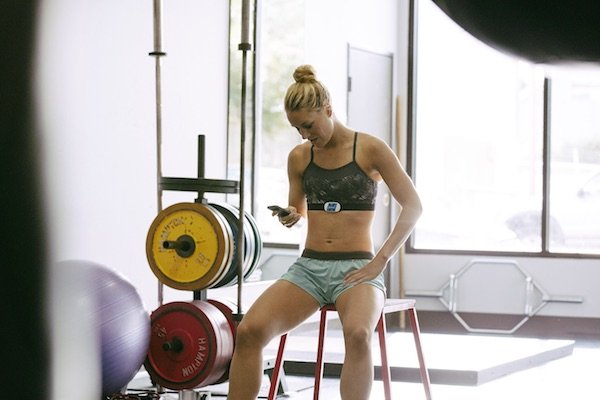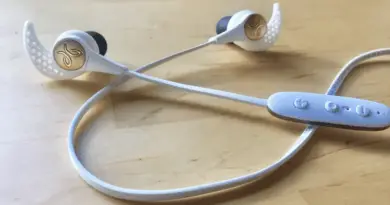Last modified on March 12th, 2022 at 10:51 am
Heart Rate Monitors For Cyclists & Runners
Editor's Choice
Wahoo TICKRx | Why It Wins |
|---|---|
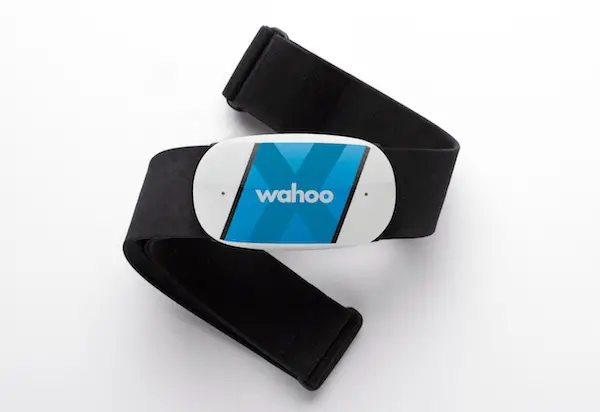 Overall Rating - 5/5 | This heart rate monitor is worth far more money than it is priced at. This Wahoo heart rate monitor doubles as a run tracker, will work indoors and outdoors, and even goes so far as to track things such as rep counting during strength training. Since it is a chest strap, it is also incredibly accurate. |
Are you curious about the different types of heart rate monitors and how using one can help improve your performance?
Well, so were we.
We created this buyer's guide to help our readers learn about their heart rate, and assess which products are best suited to help you reach your personal fitness goals. The following are the best cycling heart rate monitors of 2018.
So let's get started!
Product | Summary |
|---|---|
Garmin HRM Run | Overall Rating - 3.5/5 Chest strap monitor. Designed specifically for runners. Tracks running-specific metrics such as stride length and cadence. Great if you already have a Garmin watch to pair it with. |
Fitbit Versa | Overall Rating - 4.5/5 Optical (wrist) heart rate monitor. Doubles as a smart watch with features such as text and weather alerts. Great for everyday use. Waterproof, tracks heart rate during a variety of exercises and day to day life. |
Polar FT1 | Overall Rating - 4/5 Chest strap monitor but also comes with a watch to easily see stats. Good for serious athletes who need accuracy. It also has audible alarms so you know if you are in your target heart rate zone. |
Garmin Forerunner 235 | Overall Rating - 4/5 Optical (wrist) heart rate monitor. It can be paired with a chest strap monitor for better accuracy. It's and older model so you can find deals frequently. Best for the deal seeker who has their heart set on an optical monitor. |
Wahoo TICKRx - Editors Choice | Overall Rating - 5/5 Chest strap monitor. Best deal you'll find for all it does. It can perform programmable functions and is more than just a heart rate monitor. Comfortable, intuitive design is great for just about anyone who wants a chest strap monitor |
Things To Know Before Buying A Heart Rate Monitor
A heart rate monitor is one of the most common accessories cyclists look for. Outside of your helmet, or headphones for cycling, heart rate monitors are one of the accessories that can make the most difference in your ride.
There are many different heart rate monitors to choose from on the market today. As a cyclist or runner, when deciding which is the best heart rate monitor for your needs you need to look at two main factors; the type of monitor, and the features each monitor possesses.
On a basic level, there are two types of heart rate monitors; chest strap and wrist strap (heart rate monitor watches). It is important to know the benefits and draw-backs of each so you are able to determine the best one for you.
Using a heart rate sensor can better tell you if you are in your target heart rate zone during a workout session. Depending on your goals, this target heart rate may vary. Unless you are a seasoned athlete, most people don’t know what their heart rate should be during a workout. Before you can commit to purchasing a heart rate monitor, you need to know what you are looking at.
Finding Your Target Heart Rate Zone
Finding out the basics of your target heart rate without the help of a heart rate monitor that tracks your day to day heart rate involves a bit of math. So break out the calculator and lets get started! To find your target heart rate training zones, you need to first calculate your maximum heart rate and your resting heart rate. You can find heart rate and other health related calculators on calculators.tech. Here's how you calculate heart rate manually:
Okay, the next steps can get a bit more complicated, so let me use myself as an example. I am a 24 year old female.
Let's move on to the next steps.
This is the most simplistic method, but using a heart rate monitor on a daily basis as a general activity tracker can help you determine even more information about training zones.
In fact, there are six main zones you should train in, and each one will help you to achieve your personal goals quicker. If you have more time then you can go for a lower zone, but if you have limited time for your workout then the best way to burn your calories would be to do some high intensity interval training in a higher zone.
The Importance of Heart Rate Monitors
Heart rate monitors are important for anyone who wants to keep an eye on their heart rate during training to get the best possible workout. Competitive cyclists, runners, and other athletes should use a heart rate monitor to accurately track their progress in training and ensure a healthy, effective routine.
Choosing the best heart rate monitor can be tricky, but most of the time it is just a preference as to what will work better for each individual.
When someone starts their journey into finding a heart rate monitor that isn't for medical purposes they generally care about 2 things - finding their resting heart rate and using heart rate tracking to help them improve or track their fitness.
When you are measuring your resting heart rate, a few BPM one way or another won't make much of a difference, but you want to determine if you are in a healthy heart rate range. Similarly, when tracking your fitness, your actual BPM is less important than getting into your target heart rate zone.
Optical vs Chest Strap Monitors
When choosing a heart rate monitor for any athletic activity, the biggest thing you have to decide is whether you want to use a more traditional chest strap style which uses an electrical pulse to measure your heart rate, or whether you'd like to opt for the optical technology instead.
Optical Heart Rate Monitors
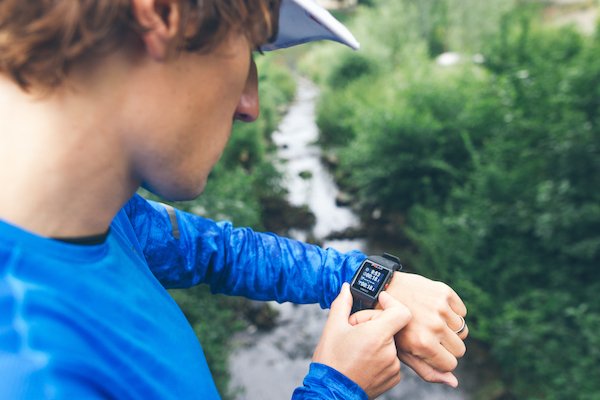
Many big names in athletic watches such as Apple and Fitbit use optical technology, and it is starting to grow in popularity. However, optical heart rate monitors are almost always going to be slightly less accurate than chest strap monitors.
They are normally found in heart rate monitor watches, and rest on your wrist, rather than directly on your heart. Optical technology sends a light into your skin and then analyzes the light that comes back. Based on the information we currently know about how light reacts to blood flow, they are able to determine your pulse. This is traditionally the main technology used in heart rate monitoring watches.
In my opinion, an optical heart rate monitor is more convenient, and I realistically see myself using it more, so they are my personal preference.
Chest Strap Heart Rate Monitors
Without getting too terribly technical, chest strap heart rate monitors are able to detect the very small electrical signal your body produces that causes your heart to constrict. These are a more accurate way to assess your heart rate, and would be a good choice if you care about pin-point accuracy for your training routine.
However, if you want to get a gauge of overall health, these are not as convenient as the optical alternative, as you only really will wear it during exercise.
Now that you know the basics, lets break it down for you a bit more.
Best Heart Rate Monitor Chest Strap
The following are our picks for the best chest strap heart rate monitor options. These are best for athletes who value accuracy over convenience and comfort. You will get a very accurate reading with all of these heart rate monitors during exercise, but you likely wont be wearing them all the time.

Pros | Cons |
|---|---|
It is a great overall heart rate monitor. It connects with a variety of phones and because it uses a chest strap, it is more accurate than cycling watches and wrist strap heart rate monitors. It offers the ability or perform programmable functions and is arguably the best bang for your buck available. | It needs to be kept clean in order to remain able to stay in place. It occasionally needs to be reconnected to your phone in order to remain accurate. It is not rechargeable, but the battery lasts a solid year without needing to be replaced. |
We are starting off this list strong. The Wahoo TICKRx is an absolute steal for what it does. It is so much more than just a heart rate monitor.
This Wahoo heart rate monitor doubles as a run tracker, will work indoors and outdoors, and even goes so far as to track things such as rep counting during strength training. It is also incredibly reasonably priced for what you get. It is arguably one of the best cheap heart rate monitor options without skimping on accuracy.
Design & Fit
At a quick glance, the Wahoo TICKRx may look like any other chest strap heart rate monitor, however, there are some key differences. On most chest strap heart rate monitors, you have the heart rate monitor itself, the strap, and on that strap is the closure mechanism.
On the Wahoo TICKRx, the closure for the strap itself also double as the snaps to keep the heart rate monitor in place. Most other options available have a separate hook and loop closure system. This not only makes the TICKRx easy to put on, it is one of the most comfortable options available.
>> If you're interested in cycling heart rate monitors, you may also be interested in cycling jerseys. Read more about them in our list of the best cycling jerseys.
Key Features
App Versatility:
The Wahoo Fitness TICKRx connects with ANT+ as well as Bluetooth and can relay that information to either an Apple or android device. It also connects with over fifty smartphone apps including the app Cyclemeter.
Tracks More Than Heart Rate:
Along with tracking heart rate and calories, if you are using the Wahoo TICKRx for running or cycling, it also tracks distance traveled and speed.
Feedback Triggers:
One common issue with using a heart rate monitor that doesn't have a screen is the inability to tell when it is actually tracking. With the Wahoo TICKRx, you get LED indicators telling you when it is tracking, along with vibration.
Customized Commands:
The Wahoo TICKRx has the very unique ability to complete programmable functions. Within the App, you can customize your TICKRx to do something (such as pause your workout or skip songs) when you double tap it.
Water/Sweat Resistance:
Well, hopefully its sweat resistant! The Wahoo TICKRx can withstand being dunked in water, but we don't recommend using it in a pool.
Battery:
It comes with a coin cell battery that should last about a year. It would be nice if it was rechargeable, but the fact that the battery life is so long makes this a non-issue.
Pros | Cons |
|---|---|
The Polar FT1 is great at what it does. It is simple to use and is great for cyclists and other athletes because of that. The screen on the watch is large, and it has audible reminders that allow the user to keep track of their heart rate without having to constantly check. | Most comparable products have multiple functionality such as calorie counting and distance tracking, however the FT1 does not. It is great at what it does: monitoring your heart rate, but doesn’t do much else. You cannot replace the battery on the chest strap. Although it lasts a long time, once the battery dies you will need to buy a replacement strap. |
Alright, so the first thing you probably noticed is this combo includes a watch. However, the accuracy of this Polar heart rate monitor comes from the chest strap. You're also probably more likely to wear a combo like this if you are already considering a chest strap.
If you are looking for a no-frills, does what it says it will do sort of heart rate monitor, this could very well be the option for you. Due to their rugged waterproof design, the FT1 is also one of the best triathlon watches in its price range.
Design/Fit
Lets first talk about the chest strap. This combo comes with the T31 coded chest strap transmitter. It is slim, light and reasonably comfortable. You place the transmitter around the front of your body, and connect the straps to keep it in place. It comes with a Medium to XXL (30-45 inches) strap which should fit most people. It's pretty standard, but we did say this was pretty no-frills didn't we?
The watch is also pretty straight forward. What you see is what you get. Polar is known for their somewhat large displays, and the FT1 is no different. It comes in black and black, so if you like black, hooray! 🙂
Key Features
Heart Touch:
The Polar FT1 is a heart rate monitor first and foremost. However, a key benefit to this combo is you also get watch functionality. By touching the watch to your heart, you are able to see the time without having to worry about pushing any tiny buttons.
Manual Target Zones:
If you're into this sort of thing and know what you're doing, the Polar FT1 will allow you to manually set your target heart rate zones for training. This allows you to really customize your workouts to fit your fitness goals.
Audible Alarm:
If you cross over your permissible heart rate limit, the Polar FT1 will give you an audible alarm. This allows you to keep track of how hard you are pushing yourself without having to constantly look down at the watch screen.
Waterproof:
The Polar FT1 is waterproof, meaning you can sweat all over it and also use it for swimming, a unique feature amount chest strap heart rate monitors.
Garmin HRM Run
Pros | Cons |
|---|---|
This highly accurate heart rate monitor is great for people who already have a Garmin fitness tracker. It is very accurate and provides far more stats than a traditional heart rate monitor. | You need a Garmin device to use it. This could be an obvious dealbreaker if you are only looking for a chest strap and don't already have a Garmin fitness tracker. |
The Garmin HRM run is a great Garmin heart rate monitor to buy if you already have a Garmin watch or fitness tracker to go along with it. It provides a ton of data, including things such as cadence, oscillation, ground contact time and more. It is a great choice if you already have a Garmin fitness tracker, and love all the juicy data details.
Design/Fit
The first thing you will probably notice about this heart rate monitor is the striking red center and a running icon to let you know this heart rate monitor is designed mostly for runners. However, it can be used for a variety of exercises and still be effective, it just has extra features that are useful to runners.
The strap is flexibly and soft and makes contact with your skin right around the rib cage. Pretty standard. It is made of nylon, so it is stretchy and comfortable.
Unlike some other chest strap heart rate monitors, the HRM run is connected to the strap with 4 small screws. This has some obvious benefits and drawbacks. On one hand, you know the heart rate monitor is never going to fall out, but on the other hand you have to break out your screwdriver if you want to remove it to change the battery.
You do not have to remove the sensor to wash the strap, as long as you are following Garmin procedure and hand washing it only. It is not machine washable.
Key Features
Garmin Connect:
As with any Garmin sports device, it comes with Garmin Connect. This allows you to compete against yourself from previous rides or have a friendly challenge among other riders in your area. This alone can help give you the competitive push that is required for you to reach your fitness goals.
Lots of Stats (For Runners):
One key factor that sets the HRM run apart from other heart rate monitors is the number of features. You can track 6 metrics: Cadence, vertical oscillation, ground contact time, ground contact balance, stride length, and vertical ratio. These are outside of the heart rate monitoring features that are useful to all athletes.
Accuracy:
Where the Garmin HRM run shines is its accuracy. It is right on par with industry standard heart rate monitors that come at a much higher price point. If you are looking to track and monitor details, this could be a great selling point for the HRM run.
Best Heart Rate Monitor Watches (Optical)
Optical heart rate monitors are appealing to those who value convenience and extended use over absolutely pin-point accuracy. I have been bouncing between optical heart rate monitors on and off for the past few years, and I have to say once it becomes part of your daily routine, its hard to imagine life without one.
The following are our picks for the best optical heart rate monitor watches
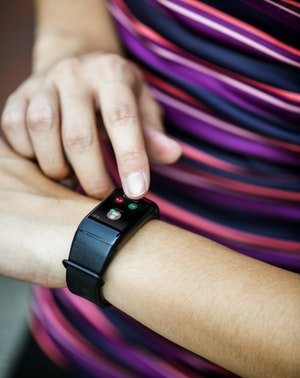
Pros | Cons |
|---|---|
The Fitbit Versa is a great all around fitness tracker with an emphasis on accurate heart rate tracking. It is waterproof, so you can use it for cycling, swimming, running and even in the shower. It comes with a variety of smartwatch features that aren't normally available at it's price point. | If you're looking for just a heart rate monitor, the Versa may be a bit much. It is great at what it does, but you're paying for extra features and if you don't need them, there are many other cheaper alternatives. |
The Fitbit Versa is Fitbit's newest smartwatch product on the market. I have always been a fan of Fitbit products because they make quality fitness trackers, but the Versa is their first real successful attempt at a smart watch. Fitness and heart rate monitoring have not taken a back seat with the Versa though. It maintains the high standard Fitbit has set for reliability and accuracy. It has improved some features that were found on older models like the fitbit blaze.
Design/Fit
The Fitbit Versa is a sleek and slender upgrade from previous models such as the Fitbit Blaze and Fitbit Charge. It keeps the same concept of essentially being a watch module that can be switched in and out of different watch bands.
The band that comes with it is a one size fits all black silicon band, which looks great with just about anything as long as you're not trying to be too terribly fancy.
The Versa is smaller than any other smartwatch-like model before it, making it a no-brainer for women. Now, this being said it can still look great on a man, it's just compact enough to look nice on big wrists as well as small ones.
Key Features
Battery Life:
When it comes to fitness trackers, Fitbit is known for having some of the best battery lives on the market. The Versa lasts up to 5 days on a single charge which allows you to use it not only as a reliable heart rate monitor, but also as a sleep tracker that you don't have to worry about charging every night.
Waterproof:
Unlike previous models, the Fitbit Versa is completely water proof. You can swim with it, shower with it, go in open water and just about anything else without worrying about damaging the unit.
Accuracy:
The Fitbit Versa's optical heart rate monitor accurately tracks your heart rate at rest, and during physical activity.
Zone Tracking:
Once you set your Fitbit Versa to start tracking your workout, it immediately tells you what training zone you are in based on data gathered from continued use. The best part about this, is its color coded. You can quickly glance down during a workout and see what workout zone you are in based on the color your heart rate is displayed in.
Smart Watch Features:
If you are in the market for a heart rate monitor watch, you probably would also like an option with a decent amount of smart watch features. With the Versa, you have access to a growing list of apps including music streaming services, maps, alarms, custom watch faces and more. You also get notifications from your phone, and as of right now, if you have an Android device, you can respond to texts right on the watch.
Fitbit App:
The Fitbit app gives you access to a suite of fitness tracking stats from your workouts and daily life. In my humble opinion, it is the best overall fitness tracking app available on the market. You can track your sleep, weight, diet, steps, period cycles (get excited ladies!) among other things.
Pros | Cons |
|---|---|
It is not the latest model so you can normally find it for a good price. It has a reliable optical heart rate monitor that will track your heart rate during exercise and at rest. This comes with a lot of extra features for the price. | It has a proprietary charger, sleep tracking can be a bit dodgy. |
An oldie but a goodie, the Garmin Forerunner 235 still managed to stand out as an excellent optical heart rate monitor and fitness tracker despite having been on the market since December 2015. It's in depth tracking and insights that future-proofed this watch when it was released still hold strong in todays market. Let's talk about this gem a bit more.
Design/Fit
The Garmin Forerunner 235 is a stylish, sleek smart watch that functions full time as an optical heart rate monitor. It comes in 3 different color combinations, Red/black/grey, black and black/frost blue. It has a pretty classic round watch face that is 1.23 inches in diameter.
If you're in the market for a touch screen, you may want to consider something like the Fitbit Versa, because the Forerunner 235 opts for side buttons instead. This is really a point of preference. Some may prefer touch screen, while others could argue that buttons are easier to navigate when training.
By default, it comes with a silicon strap but you can switch that out if you want to dress it up. Overall, this is a pretty aesthetically appealing optical heart rate monitor that can be worn for almost all occasions.
Key Features
Older Model = Lower Price:
Since the Forerunner 235 has stood the test of time, it is still a great option even years later. Garmin has since released newer options, lowering the MSRP of the Forerunner 235. Hooray!
Can Be Paired With Chest Straps:
For those of you open to the idea of using a chest strap, pairing that with the Garmin Forerunner 235 give you the ability to increase your accuracy while still providing an easy to access wrist-view for your stats.
VO2 Max Readings:
You VO2 max is the maximum amount of oxygen you can use. This reading is powered by the heart rate monitor and estimates your overall fitness level.
GPS Tracking:
If you like bells and whistles with your heart rate monitor, the Forerunner 235 offers the ability to track your GPS on rides and locks on quickly with reasonable accuracy. If you're interested in GPS tracking, you may also want to check out our review of the best GPS cycling watches (read more).
Sport Modes:
Depending on the sport you choose, the Forerunner has 4 sport modes to choose from. Run, Run Indoor, Cycling & Other. This gives you the ability to reflect on your heart rate and overall performance during different exercises.
Activity Tracking:
In addition to monitoring your heart rate while you exercise, the Forerunner 235 will measure it during daily activities, while at rest and also monitor your overall activity level. It reminds you to take steps and if you're into this sort of thing, it can use this info to compare your stats to friends and other Garmin users so you can try to out-step them!
>>We compared the Garmin Forerunner 235 vs the 230. Want to see how they differ? Learn more.
What is The Best Heart Rate Monitor?
After looking at these different heart rate monitors, you should ultimately decide which is the best heart rate monitor for you based on your overall needs.
If you are looking for top-of-the-line quality, with a price to match, the Garmin Edge 820 plus the performance bundle is an excellent choice. When all you really want is a heart rate monitor, then go with the Polar FT1. If you are looking for a heart rate monitor that still can track your calories burned and track your distance, then the the Wahoo TICKRx is probably the way to go. For a very reasonable price, the Wahoo TICKRx appears to do everything that most cyclists would need minus GPS capabilities.
Whether you are looking for a monitor with everything or just something simple, it is still very important to choose one that fits your needs and helps you accomplish your personal goals. Having a heart rate monitor can help you to train better and get the best possible workout. They can help make sure that you are exercising in your target zone, and not over or under exerting yourself for your safety. After all, cycling is a lot more fun when you know what your body can do.
Do you prefer chest strap or optical heart rate monitors for fitness tracking? Let us know in the comments section below!
What Do You Think?
Now it's your turn! If you think we missed anything, let us know in the comments section below.
Also....before you go...let us know
Is accuracy or convenience the #1 factor in choosing a heart rate monitor? Comment below 🙂
I have been a nature enthusiast since I was a small girl. My background is in online marketing and website development. It only makes sense to merge my love for nature with my skills in online marketing to help spread awareness, and appreciation for Our Beautiful Planet.






